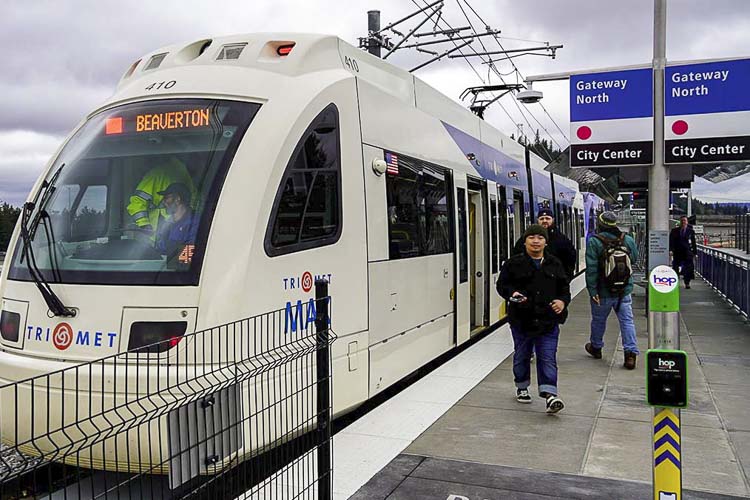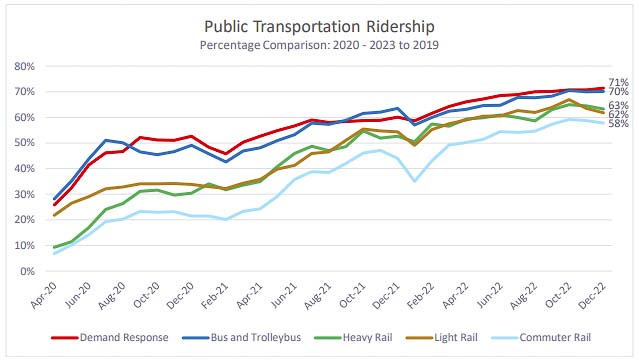
The $215 million expansion adds additional service for Washington County and extra track to the PDX airport
John Ley
for Clark County Today
TriMet and all transit agencies have taken a beating over the past four years, due to the pandemic lockdowns and the fear of COVID. Ridership plummeted by 60-90 percent or more before beginning to recover. It remains well below 2019 levels at a majority of transit systems around the nation including TriMet and Clark County’s C-TRAN.
In 2021, TriMet began a $215 million expansion of its Red MAX line, which contained multiple components. A critical piece was a 10-mile extension of the Red Line from Beaverton to Hillsboro to attract more Washington County riders. Another component was adding another train track from the PDX airport, and expanding the Gateway transit center in east Portland, near I-205.
This is of interest to Clark County residents as the Interstate Bridge Replacement Program (IBR) is proposing a 3-mile, $2 billion MAX light rail extension into Vancouver. TriMet is demanding 19 new light rail vehicles as part of the program, in addition to $21.6 million in “new revenues” (taxes) from both Oregon and Washington taxpayers to cover operations and maintenance of light rail. The plan includes two new light rail stations in Vancouver, one about 80 feet above the ground at the waterfront, and the other at Evergreen.
The “Better Red” improvements include a new “north” stop at the Gateway transit center in east Portland, and adding a new (second) track to the PDX airport. The Gateway north MAX station exclusively serves Red Line trains coming from Portland International Airport. Riders heading to the airport from city center will continue to ride MAX Red Line trains northbound, which pass through the Gateway Transit Center.
TriMet’s “A Better Red” project cost $215 million, which includes four new light rail vehicles to handle increased Red Line service to Hillsboro. The price per vehicle is $4.5 million, according to TriMet spokesman Tyler Graf.
Here are the project funding sources, broken down to reach the total $215 million project cost.
- $104 million TriMet
- $99.9 million Federal Transit Administration Small Starts / SYGA
- $8.9 million Regional Flexible Funds administered by Metro
- $2.2 million Port of Portland
“On the east side, we did add an additional set of tracks near PDX and Gateway Transit Center, along with new bridges to carry southbound trains over I-84 and Union Pacific Railroad tracks north of Gateway, which increases reliability. The Portland International MAX Station was given a full renovation. The break facility at the new end of the line for the MAX Red Line, at Fair Complex/Hillsboro Airport Station, for operators, field staff and safety & security staff was rebuilt and expanded. And there’s the new station that we built, Gateway North, which serves trains coming from Portland International Airport.’’
Clark County Today asked how many additional riders TriMet is forecasting will use the Red Line because of the “Better Red?” What, if any, will be the impact on ridership on the Blue Line?
“We have not run new numbers since the pandemic, and a ridership forecast was not required for a Small Starts project,” Graf responded. “Nonetheless, the extension will add more MAX capacity in a growing part of Washington County that experienced overcrowding pre-pandemic.”

“The Gateway Transit Center portion of the project involved the construction of a new inbound-only MAX station, Gateway North, for trains heading from PDX toward Downtown Portland and the west side. That required the construction of a second track, with bridges over the freeways. The goal of that was to improve how trains move through the transit center by alleviating a choke point. The result is a more reliable and resilient light rail system, with fewer delays and disruptions for riders.”
TriMet provided a breakdown of the major cost components of the project.
Current major project component costs are about $145 million. A breakdown includes:
- Fairplex operator break building: $2.4 M
- Track & aerial structures: $42.4 M
- Platforms & shelters: $6.5 M
- Earthwork, walls, temporary facilities: $55.2 M
- Systems, communication, train control: $39.6 M
- Remainder: project design, design services during construction, construction management (TriMet labor & outsourced labor), Right-of-Way acquisition, permits, ODOT IGA, start-up training and shuttle buses used to serve MAX stations during service disruptions.
The new tracks from the Portland airport to the Gateway Transit Center run approximately five miles, and included some new bridges and elevated station work. But that would equate to about $8 million per mile for a new set of tracks.
Overall, this would appear to be a much better “bargain” than what the Interstate Bridge Replacement program is seeking in the $2 billion, three-mile light rail extension.
Also read:
- Delays expected on Northwest 99th Street during water quality project constructionClark County will begin construction in July to install a stormwater filter vault on NW 99th Street. Drivers can expect delays, but lanes will remain open during the work.
- POLL: What’s the biggest concern you have with the current I-5 Bridge replacement plan?As costs rise and Oregon’s funding fails, concerns mount over the current I-5 Bridge replacement plan. Clark County Today asks readers: what’s your biggest concern?
- Plan ahead for ramp closures on I-5 near Ridgefield, July 8-9Travelers on northbound I-5 near Ridgefield should prepare for ramp closures July 8–9 as WSDOT crews conduct final testing of new wrong-way driving detection systems. The closures affect exits 9 and 11, including the Gee Creek Rest Area.
- Oregon DOT director calls transportation funding bill failure ‘shocking,’ warns of layoffsODOT Director Kris Strickler warned staff that up to 700 layoffs are imminent after lawmakers failed to pass a transportation funding bill, deepening the agency’s $300 million shortfall.
- New crossing opens over SR 500 in VancouverWSDOT has opened a new pedestrian and bike bridge over SR 500 in Vancouver, restoring direct and ADA-accessible access for people walking, biking, or rolling.









